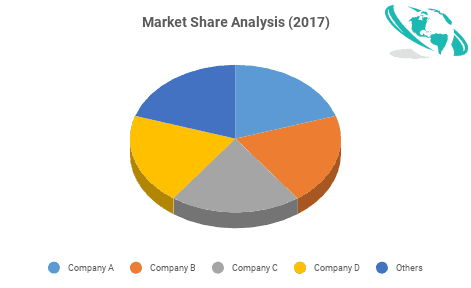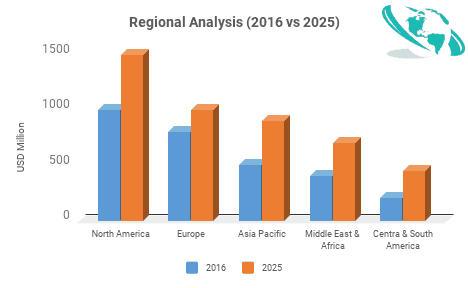
Logistics Automation Market Size, Trends & Analysis - Forecasts to 2025 By Component (Transportation Management, Warehouse & Storage Management), By Organization Size (Large Enterprises, SMEs), By Vertical (Retail & E-commerce, Oil, Gas, & Energy, Pharmaceuticals & Healthcare, Logistics & Transportation, Aerospace & Defense, Food & Beverage, Chemicals, Automotive, Manufacturing, Others), By Region (North America, Europe, Asia Pacific, Central & South America, and Middle East & Africa); End-Use Landscape, Vendor Landscape, and Company Market Share & Competitor Analysis - Global Market Estimates
Logistics Automation Market Insights
The logistics automation market is estimated to grow at a CAGR of approximately 12% from 2017 to 2025. Ever-growing e-commerce industry, new innovations in robotics and emergence of the Internet of Things (IoT) technology are some of the factors expected to drive the logistics automation market. The implementation of driverless vehicles and drones is playing a vital role in automating logistics processes and providing lucrative growth opportunities to vendors of logistics automation solutions.
IoT technology essentially enhances connectivity and automation. This enables organizations to utilize the technology in warehouses which would result in more productive and cost-efficient outcomes. The implementations of IoT technology in logistics management enables companies in tracking material deliveries, monitor sensitive goods, and also alleviate any transportation risks.
Deployment of automation solutions in the logistics industry requires high capital investment. Subsequently, in order to maintain operational efficiency, companies need to invest in upgrades and maintenance more frequently. While large-scale organizations can afford such expenditure, the inability of small and medium-sized companies to do so might be a potential market restraint. However, with increasing applications of automation and competition in the market, these costs are expected to gradually decline.

Logistics Automation Market: Component/Organization Size Insights
The logistics automation market based on the component is segmented into warehouse & storage management and transportation management. The warehouse & storage management segment is likely to dominate the logistics automation market in 2018. The growth of the warehouse & storage management segment is due to innovative technologies being implemented to optimize warehouse operations.
Based on organization size, the logistics automation market is segregated into large enterprises and SMEs. The small & medium-sized enterprises segment is expected to grow faster than large enterprises over the period forecast on account of declining automating warehouses and transportation costs.
Logistics Automation Market: Vertical Insights
Based on vertical, the global logistics automation market is classified into retail & e-commerce, oil, gas, & energy, pharmaceuticals & healthcare, logistics & transportation, aerospace & defense, food & beverage, chemicals, automotive, manufacturing, among others. The retail & e-commerce segment is likely to dominate the logistics automation market over the forecast period. Increased adoption of logistics automation solutions, demand for automated production and flexible logistics systems are some of the factors driving growth of the logistics automation market in the retail sector.
Logistics Automation Market: Regional Insights
North America is expected to lead the logistics automation market in terms of market size. In order to improve supply chain operations, manufacturing, assembling and goods transportation, there is an increased demand for logistics automation systems from companies in North America.

Logistics Automation Market: End-Use Landscape
The end-use landscape entails a list of current and prospective consumers prevailing across the regions. This section provides company addresses, contact details, products, and regional presence of companies who are purchasing or are likely to purchase logistics automation over the coming years. Some leading consumers of this market are Amazon, XPO Logistics Inc., Alibaba and DHL Supply Chain among others.
Logistics Automation Market: Vendor Landscape
The report contains a chapter dedicated to vendors operating in the market, covering raw material manufactures, equipment developers, manufacturers, and distributors. The report provides these insights on a regional level. This section of the report entails contact details, experience, products manufactured/supplied, and geographical presence of companies.
Logistics Automation Market Share & Competitor Analysis
Key players currently operating in the logistics automation market include Dematic Corporation, Daifuku Co., Ltd., Murata Machinery, Ltd., Honeywell Intelligrated, Inc., KNAPP AG, Swisslog Holding AG, TGW Logistics Group GmbH, SSI Schaefer AG, Mecalux, S.A., and Toshiba Logistics Corporation among others.
Please note: This is not an exhaustive list of companies profiled in the report.
In 2016, Honeywell acquired Intelligrated, a leading North American-based automated material handling solutions provider at $1.5 billion.
In April 2018, Dematic, a supplier of automated technology for supply chain, introduced a portfolio of automated solutions to make the piece, case and pallet handling more efficient, productive and responsive to the on-demand omnichannel distribution environment.
We value your investment and offer free customization with every report to fulfil your exact research needs.
The global Logistics Automation Market has been studied from the year 2016 till 2025. However, the CAGR provided in the report is from the year 2017 to 2025. The research methodology involved three stages: Desk research, Primary research, and Analysis & Output from the entire research process.
The desk research involved a robust background study which meant referring to paid and unpaid databases to understand the market dynamics; mapping contracts from press releases; identifying the key players in the market, studying their product portfolio, competition level, annual reports/SEC filings & investor presentations; and learning the demand and supply side analysis for the Logistics Automation Market.

The primary research activity included telephonic conversations with more than 50 tier 1 industry consultants, distributors, and end-use product manufacturers.

Finally, based on the above thorough research process, an in-depth analysis was carried out considering the following aspects: market attractiveness, current & future market trends, market share analysis, SWOT analysis of the company and customer analytics.

Tailor made solutions just for you
80% of our clients seek made-to-order reports. How do you want us to tailor yours?
OUR CLIENTS